By Dominique Malaquais
Against Teleology
For some years now, scholars in a range of fields have been arguing that canonical approaches to urban space fall short when faced with cities like Kinshasa.1 Despite claims to universal applicability, such approaches tend to be thoroughly Eurocentric. Rooted in the Modernist project,2 they favour teleological narratives of progress in which the self-professed centre, the Euro-American metropolis, serves as the model and benchmark. At their core is a reliance on dichotomies – centre vs periphery, formal vs informal, success vs failure – that cannot effectively account for diversity: for ways of experiencing, structuring and imagining city life beyond the confines of a world narrated by Lewis Mumford and his followers.3 Such either/or readings of urban space have a pernicious effect that extends far beyond the realm of philosophical difference. At the hands of the IMF, the World Bank and related institutions, or deployed by state-sponsored local and regional planning bodies, they shape policy and as a result impact millions of lives, more often than not in distinctly negative ways.4
Examples of this abound. Simplistic visions of Johannesburg as a metropolis divided between haves and have-nots, the latter perceived as likely to impede the city’s growth, attended many a step in the build-up to the 2010 World Cup. Evidence of this is rife in the form of massive over-investment in infrastructure – stadiums and hotels most notably. The latter will not only fail to bring in long-term revenue, but also, because of their restricted access, will exacerbate tensions, widening divides infinitely more complex than those envisaged by rich versus poor, underclass versus the rest dichotomies that shaped the artificial growth spurt prompted by the World Cup. The branding campaign aimed at reinventing Johannesburg as the centre of a fictional world united by soccer – one planet, under futbol, with liberty and justice for all – has proven as flawed as the linear logic of countervailing forces on which it was premised, and just as unlikely to yield positive results.5
At the risk of drawing overly easy comparisons between what are evidently very different cities, one might point to parallel developments in Cairo and Nairobi, to give but two examples. In both cases, the last decade and a half has brought a noxious mix of branding techniques aimed at attracting a small cadre of foreigners (investors, tourists increasingly difficult to come by in a post-911 world) and Los Angeles-inspired expansions on the center/periphery model once imposed on urban space by colonial authorities. The result has been investments in infrastructure that largely benefit small pockets of well-to-do city dwellers. Patterned on unimaginative Modernist templates, such developments are increasingly packaged as post-modern, post-colonial and, to differing extents, post-racial (alternatively post-ethnic) initiatives. Tired approaches to urban space, tried and true in their ability to fail the majority in favour of the minority, are being trotted out in brand-new garb designed by advertisement agencies for display on CNN International and BBC, in assorted investment brochures and in onboard airline magazines distributed free of charge to business travelers.6
This is not the stuff of bureaucracies and ad agencies alone. Lagos is instructive in this regard. Despite what are undoubtedly good intentions, precisely the same kinds of dichotomies structure the response of one of architecture’s most successful figures, superstar planner/designer Rem Koolhaas, to West Africa’s megalopolis of record. His Lagos Wide and Close7 has become a must-cite for commentators on ‘the African city’ (this a highly problematic category, for it suggests the existence of both a unity – basic similarities between such disparate entities as Marrakech, Dakar and Antananarivo – and an analytical framework capable of theorising such unity, neither of which in fact exists). Premised, at times in spite of itself, on overly simplified distinctions between centres and peripheries, foregrounds and backgrounds, formal and informal (or ‘shadow’) economies, Koolhaas’ reading of Lagos claims to tell a radically new story and does precisely the opposite.
Haunted by the ghost of Lewis Mumford and the intimate links that his Culture of Cities8 bears to the colonial enterprise,9 the Dutch architect’s take has hit home in ways at once mind boggling and wholly predictable. What appeared in its early days as an exercise in highlighting alternative, grassroots (inhabitant-driven) ways of shaping city space has been funneled into a full-blown branding project. The eponymous ‘go-slow’ – the (now) world-famous Lagos traffic jam, a very particular incarnation of Hell to which one might be forgiven for wishing to confine the CEOs of General Motors, Toyota, Shell and BP – has spawned a Prada store in downtown Manhattan, Koolhaas claiming the one as influence for the other,10 and a gargantuan bridge. The latter, the Fourth Mainland Bridge, to be designed by Koolhaas’ firm, OMA, is advertised as the solution to Lagos’ go-slows,11 but of course will be nothing of the kind. It will make access to the wealthy parts of the city easier, that much is true, but will likely do little for the intractable snarls that bring movement to a standstill on the mainland, where the overwhelming majority of Lagos’ inhabitants live.12
Babatunde Fashola, the governor of Lagos State and a superstar in his own right, clearly sees the construction of Koolhaas’ bridge as a branding move and in this he is correct. In an age of fascination with failure and responses to it in bite-sized, easy-fix increments (not for nothing is reality TV a global growth industry), the story of urban implosion/explosion told by ‘Lagos Wide and Close’ has morphed into a selling point, attracting national and international political and financial goodwill to a neoliberal project that will see the city transformed in ways likely to serve its tiny bourgeoisie well and the rest of its inhabitants very little. The whole endeavour reads like a made-for-TV script: Big (white) Man – Koolhaas – diagnoses failure, drawing attention to lives marked simultaneously by pathos and resilience in an unjust yet burgeoning world; in response, other Big (black) Man – Fashola – is inspired to effect radical transformation; together, they change the very face of the city and, in the process, (urban) history. The back story is a tired Modernist teleology, fictive through and through: the periphery moving from worse to better by way of the centre.
Unsurprisingly, the same type of teleology characterises interventions by political leaders and entrepreneurs into the urban fabric of present-day DRC. Public-private consortia linking the governments of Congolese president Joseph Kabila and his Chinese counterpart Hu Jintao with Beijing, Shanghai and Guangzhou-based capital are hard at work in Kinshasa’s ex-colonial centre (Gombe and neighbouring Lingwala), now touted as a hub of formal (state-regulated) business, transforming shaded two-lane roads into treeless multi-corridor arteries. An Australian-Zambian investment group is advertising a gated city-within-the-city positioned astride the Congo River, La Cité du Fleuve, simultaneously minutes away from Gombe by speedboat and a world away from what, in scare tactics cribbed from the screenplay for Escape from Manhattan, are presented as the capital’s cutthroat streets.13 Echoes of Lagos, here, are uncanny: the Koolhaas-Fashola Fourth Mainland Bridge project calls for precisely the same kind of ‘safe’ city-within-a-city, a ‘new city centre on an artificial island’ in the Lagos Lagoon, and, in a similar vein, a Chinese-Nigerian consortium is touting a high-tech, ultra-secure satellite city, also off the Lagos coast, the Lekki Free Trade Zone.14
Half a continent away, Lubumbsashi is being rebranded as a foreign capital(ist)-friendly city by Moïse Katumbi, the governor of resource-rich Katanga state, with the active help of a French documentary filmmaker, Thierry Michel, author of a trilogy spanning the Mobutu, Kabila Sr. and Kabila Jr. regimes, the final installment of which is a virtual hagiography of Katumbi – a stunning reprise of the Modernist teleology that manages to equate the mining business with a concern for human rights.15 Here too, plans are underway for the construction of a gated luxury enclave, Luano City:
[In] Africa – the last frontier – out of the ashes, a whole new city arises [the website for this other city-within-a-city intones]. The size of Dubai Land and half the size of Paris, [it is] [a]ll you need, [a]ll you want [a]nd all you can possibly imagine: a safe and secure centralized environment and an unsurpassed investment opportunity … enclosed in a 474 ha mixed-use development.16
Méga Mingiedi and the Art of Anti-Teleology
As previously noted, for some time scholars have been railing against such (neo) Modernist approaches to urban space. The results, in terms of real-world application, however, have been tenuous. The Fourth Mainland Bridge episode suggests as much: more than a few of us have spoken out against problems inherent in Koolhaas-inspired takes on Lagos (and cities more generally), to precisely no effect. Clearly, the message is not getting through. More powerful voices are needed: voices likely to make more sense, or more noise, if only because they are more direct. Activist multimedia exhibitions that engage with the theme of the city might offer a platform to this end (‘Afropolis – City, Media, Art’, which previewed in the summer of 2010 in Nairobi and opened in November 2010 in Cologne, is one example17). If they harbour a hope of succeeding in this regard, however, it is less by way of texts such as the present one – though hopefully words such as these may be of some use – than through objects they can highlight: photographs, videos, recordings, drawings and paintings, installations, ephemera made/gathered by creators whose experience of a city such as Kinshasa allows them to offer fresh narratives. A case in point among such creators is multi-media artist Méga Mingiedi, whose work does significant damage to normative Modernist practices of map-making.
How, precisely, to characterise Mingiedi’s production is a conundrum. A discombobulating mix of graphic poetry, collage, architectural drawing and cartography – part sketch, part comic strip, and part lovingly detailed account of over-arching urban vistas and tiny street-corner details – it defies categories. No maps of Kinshasa have come as close as his work does to accounting for the complexity of the city he calls home and few writings, even by the very best (De Boeck, Gondola, Simone), have managed to be as direct. Had novelist Sony Labou Tansi, Kinshasa’s most brilliant storyteller, lived to see the 21st century, one imagines he would have been a fan.
The strength of Mingiedi’s maps – let us call them that – lies in two characteristics of his work, both of which constitute a radical departure from canonical mapping techniques: its staunch refusal to consider urban space from a single perspective, resulting in cityscapes that look deceptively linear, yet on closer inspection turn out to be equally (il)legible from left to right and top to bottom; and their fundamental ambivalence, a push-pull of simultaneous desire and recoil that puts in intimate proximity two entities that Modernist discourse on the city insists are wholly incompatible: the ‘jumble’ of spaces born of ‘informal’ economies and the ‘order’ imposed by ‘formal’ planning.18 These two features – a multi-positional vantage point resistant to any single linear perspective and an unwillingness to come down on either side of what the work shows to be a wholly artificial dichotomy – puts Mingiedi’s readings of city space at loggerheads with officially sanctioned approaches to the city, and with current urban renewal projects in Kinshasa and DRC more widely.
On the Art of Seeing from Multiple Perspectives
‘Kin Délestage’ (2010), one of Mingiedi’s more accessible works, provides a useful starting point (Fig. 1).19 At first glance, this large piece appears to present a linear view of the city. Its horizontal format and the artist’s use of both vanishing points (in checkerboard on the left) and arrow-like lines linking one side of the composition to the other suggest a fairly straightforward reading from left to right. This in turn seems to accord with the theme of the work. The focus of the piece is load-shedding practices that result in large portions of the city living for days without electric power, while the inhabitants of tiny wealthy enclaves enjoy the comforts of generator-powered air conditioning, internet access and lighting.20 Read thus, from left to right (and, in parallel, top to bottom) ‘Kin Délestage’ appears to propose in visual form a boilerplate analysis of economic inequality, with resources and labour moving in one direction, from the jumble of an informal city that serves as the artist’s vantage point (on the left), to the clinical order of a distant formal city to which he has little access (on the right).

Closer scrutiny suggests a different narrative. Indubitably, wealth and Modernist ideals of development – symbolised by a high-end timepiece, complete with thumb-like appendage poised on the stopwatch function – suffuse the city at right. Several of the features that identify the city as ‘modern’, however, are present also in the evidently less-well-off city on the left: skyscrapers and antennas most notably. The city on the left boasts more roads than its counterpart at right; infinitely more movement, a sine qua non of business, is possible there. Kinshasa’s single most quoted visual icon of modernity, an immense cement and steel tower-cum-monument erected in the Mobutu era and key to political discourse under Kabila father and son, though it tends toward centre, is unequivocally located in the left-hand city.21 These various elements speak of significantly more balance between the two halves than seemed present at first glance – or, in any event, of a push-pull that casts doubt on the viewer’s initial reading of ‘Kin Délestage’.
This sense of doubt is accentuated by a kind of seepage that draws the attention as one begins to look more closely at the piece. An undertow – a manner of sucking force – seems to be at work and objects and materials sluice back and forth between the two ends of the city. Buildings, or more properly their foundations and bottom stories, cannot seem to decide which side they are on. The roads on the left might be curvier and narrower than their runway-like counterparts on the right, suggesting an older pedigree (some, indeed, are recognisable as thoroughfares laid down in the late colonial and early Mobutu eras), but their tangle seems in places to be exerting an irresistible pull, slurping up like so many strands of spaghetti the linear perfection of the roads on the right. A peculiar sludge – a red/green/blue mix of water, bubbles, minerals and gems – is seen as if travelling back and forth between the two extremities of the cityscape, settling at neither end. A stream of spirits, in the form of cruciform designs patterned on the logo of Primus beer, Kinshasa’s drink of choice, tethers one side to the other. Squint slightly, as you might after one bottle too many, and the blue-and-white crosses start to look like blinking lights – whether garlands of miniature electric bulbs strung from lamp-posts at Christmas or emergency flashers on the roof of a police cruiser is (willfully) unclear – enveloping the two cities in a single, electropop loop.
No one perspective – left-to-right or right-to-left – makes more sense than the other. While Mingiedi’s location seems clear enough (the presence of two mouths on the left says as much: this is his point of departure, the locus from which he is speaking), the city is just as clearly in flux and this makes the artist’s position – formal and conceptual – significantly less clear than even he might like. Still closer scrutiny highlights a front-to-back and back-to-front push-and-pull that further complicates the possibility of linear readings. Spend too much time looking at ‘Kin Délestage’ and you start to feel a bit nauseous, as if your eye had somehow become attached to a bouncing soccer ball (an example of which turns up, uncannily, near top left).22
Dangers and Pleasures of Ambivalence
The result of all this is a distinct sense of unmooring – a feeling akin to that described (in an entirely different context) by novelist Richard Russo as being ‘not quite plumb’.23 Underlying this sensation, present but just out of sight, is a niggling doubt as to whether the artist himself knows where he stands – ethically, politically – in relation to the push-pull of the two cities. It seems fair to say that he is more comfortable on the left; the sheer amount of detail that he builds into the picture there is telling, as is the fluid mix of humour, irony and dead-serious precision that characterises the left side of the composition. At the same time, one would be hard put to overlook the sense of distant perfection that marks the right-hand city. The careful order in which the buildings are arrayed – in a rhythmic dentate pattern at top and a gentle ascending curve at bottom – recalls rows of bottles in a well-stocked bar, a recession-proof establishment such as one might find in the lobby of an international hotel in Gombe. There is a certain wistfulness here that suggests a latent desire for something else: for an experience of the city distinct from the everyday haphazardness of the vibrant but intensely complicated districts Mingiedi calls home.
The question of what precisely that something else might be, adds several layers of complexity to the piece and to Mingiedi’s work more generally. At the core of the matter is the figure of Mobutu Sese Seko: not so much the man himself, at whose name the artist grimaces, as what certain aspects of his three-decade reign represent. As is common in cities wrecked by war or recovering from political upheaval, there is in Kinshasa a widespread nostalgia for something past and no longer attainable – a hazy, dreamlike recollection of what the city once stood for in the eyes of others abroad. East Berlin is one such city, Moscow, in its poorer districts, is another. In Mingiedi’s city, comparisons are made at every turn between ‘Kin la poubelle’ (Kin as trashcan) – the capital in its current form – and ‘Kin la belle’ – a city, so the (much romanticised) story goes, that not so long ago was one of the continent’s urban jewels. The principal characteristic of that city, part fact and part fiction, was its identity as a Modernist entity. Although its origins as such lie in the colonial period – in Congo as elsewhere (Eritrea, Algeria, Mozambique) colonial regimes treated cities under their rule as platforms to experiment with space and form in ways impossible back home, resulting at times in pockets of high Modernist extravaganza – ‘Kin la moderne’ is recalled today primarily as a project of the early Mobutu era. The recollection is not wholly inaccurate: in the later 1960s and the first half of the 1970s, Mobutu expended gargantuan sums on constructing an image of his capital as an ultra-modern metropolis – a case in point being the massive restructuring of downtown Kinshasa that he launched in preparation for the Ali/Foreman ‘Rumble in the Jungle’, held there in 1974.24
Elements of that other Kinshasa are present in the overwhelming majority of Mingiedi’s works. Icons of the period appear over and over again: the tower-cum-monument mentioned earlier (Fig. 2A); various stadiums that Mobutu refurbished (for the Rumble, notably) and built from scratch to serve as stages for his (in)-famous displays of political and military might; military bases and airports (Fig. 2B and 2C); Mont Ngaliéma, in the western part of the city, atop which stood Mobutu’s fabled and feared Marble Palace; the TRICO II nuclear reactor, sub-Saharan Africa’s first, also positioned atop an outcropping overlooking Kin (Mont Amba).25 Many of these sites are now closed or crumbling, having fallen prey to looting (the Marble Palace), catastrophic erosion (TRICO II), financial implosion (military bases) and other debacles. In Mingiedi’s drawings, however, they appear as new. Referenced in images of these sites, in collaged scraps of (now useless) Zaire bills adorned with his effigy (Fig. 3A), in invoices made out to him as if he were still alive (Fig. 3B) and in hand-written calculations that point to a time in the 1970s when the Zaire was a currency to reckon with (Fig. 2B), Mobutu haunts Mingiedi’s maps of Kinshasa. Seen and unseen, he is present everywhere.



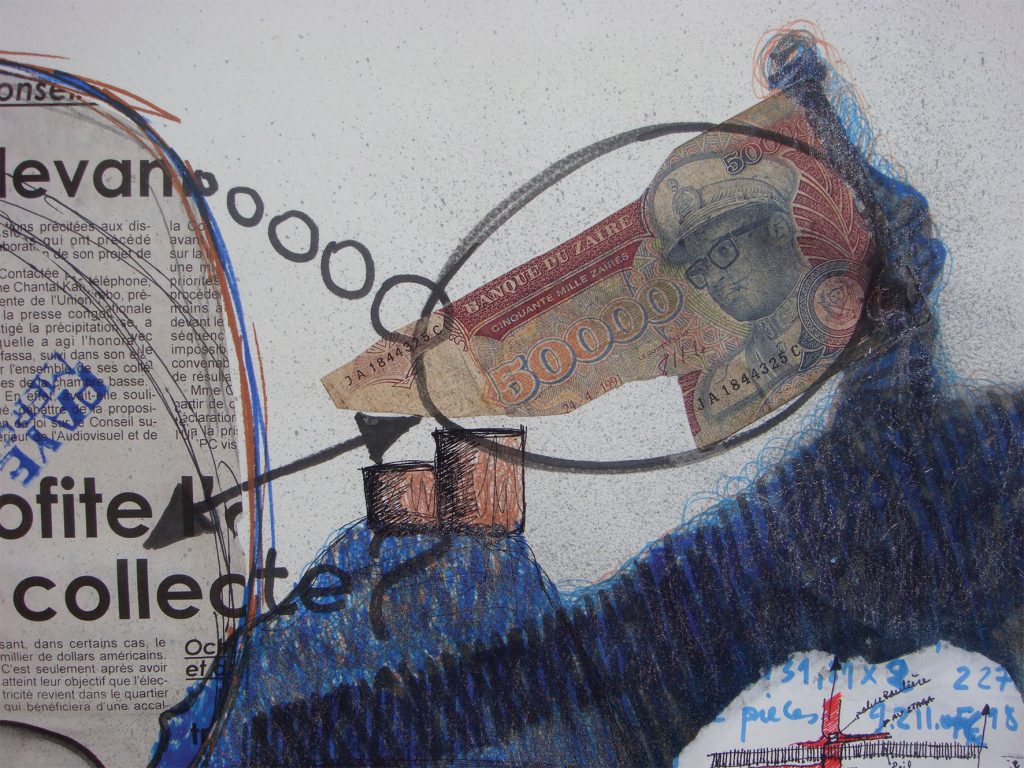

Between this spectral presence and the push-pull of left- and right-hand city in the drawing with which we began, there is an intimate tie. The city on the right is arguably Mobutu’s dream, untouched by the disaster that the megalomania of this very same dream let loose on Kinshasa. Seen in this light, the precise, clinically-rendered city on the right emerges as a wholly ambivalent space – ambivalent, that is, for the artist, who like many young men of his generation is both too young to have experienced ‘Kin la (supposed) belle’ of the early 1970s and too old to have escaped the hell that befell the city in the final years of Mobutu’s reign. Desire and detestation, (grudging) pride and appalled recognition are present in equal measure here, giving the lie to those who would offer simple before-and-after readings of the city or its inhabitants’ experience of it.
Slippage, Collapse and the Mind-Mapped City
Mobutu’s spectral presence extends beyond Mingiedi’s cityscapes. As most any Kinois will tell you, it haunts the city as a whole and much of DRC to boot. The man might be dead, but his spirit is fast afoot, prompting odd slippages in which present, past and occasionally future seem to collide.
The matter of the future is particularly striking. Mobutu had a fascination for things sci-fi. The funds he sank into TRICO II are a case in point: the reactor was not meant to produce much-needed electricity locally, and indeed it never did, but instead to conduct cutting-edge scientific research on a global scale (which it also failed to do).26 In a similar vein, Mobutu was determined that Zaire should be the first African nation to put a man on the moon and so, at exorbitant cost (some 10 billion dollars as rumour would have it)27 he launched the continent’s first space programme.28 This predilection for things futuristic finds tangible form in the shape of the city. The massive tower/monument that looms over Kin – a monument to Patrice Lumumba, of all things29 – is a veritable paean to Afrofuturist architecture, which shifts here from the realm of Afro-British speculation à la Kodwo Eshun to a full-fledged incarnation of Sun Ra’s most ambitious designs (Fig. 4).30
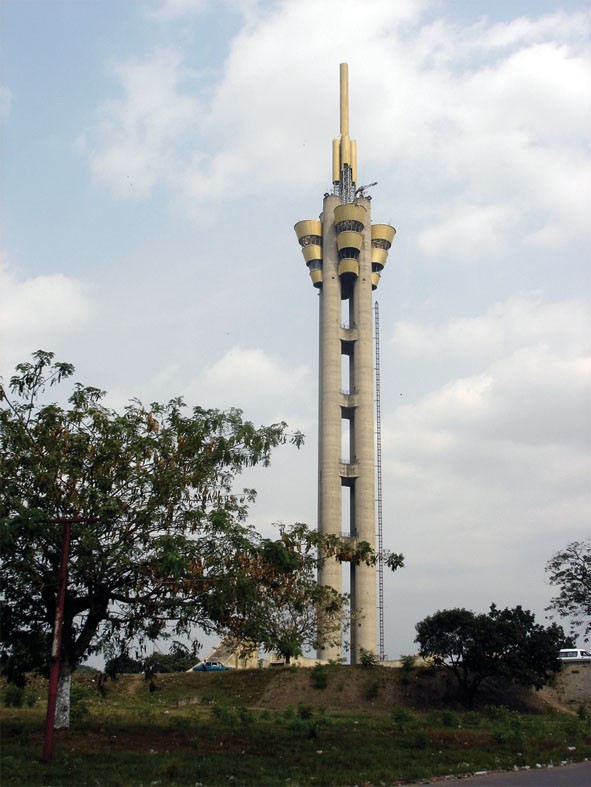

Though, no doubt, many other influences can (and should) be adduced, this sci-fi fascination of Mobutu’s has left its mark not only on the city itself, but also on ways in which artists engage with and seek to transform it.31 Indeed, few cities anywhere can boast as rich a body of Afrofuturist production in the arts as can Kinshasa. Examples of this are legion: Bodys Isek Kingelez, of course, whose futuristic city maquettes have become all the rage since they were first shown in the 1989 exhibition ‘Magiciens de la Terre’;32 less well know though significantly more varied and sophisticated, the models, machines and installations created by Pume Bylex for a putative urban future;33 Bienvenu Nanga’s life-sized and winged robots;34 Bebson de la Rue’s iridescent devices for mind travel (part spaceship, part bunker and hobo’s cabin) (Fig. 5), by far the most interesting because imbued with a genuine Afrofuturist ethos;35 and Mowoso’s radical re-readings of urban space through Skype and video performances that collapse cities into and onto one another, resulting in mind-bending urban hybrids (Fig. 6).36
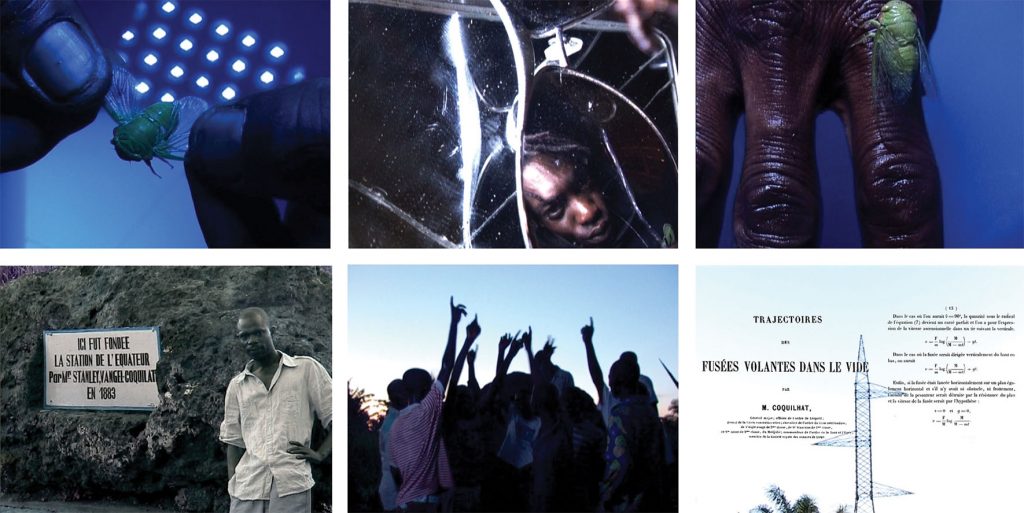
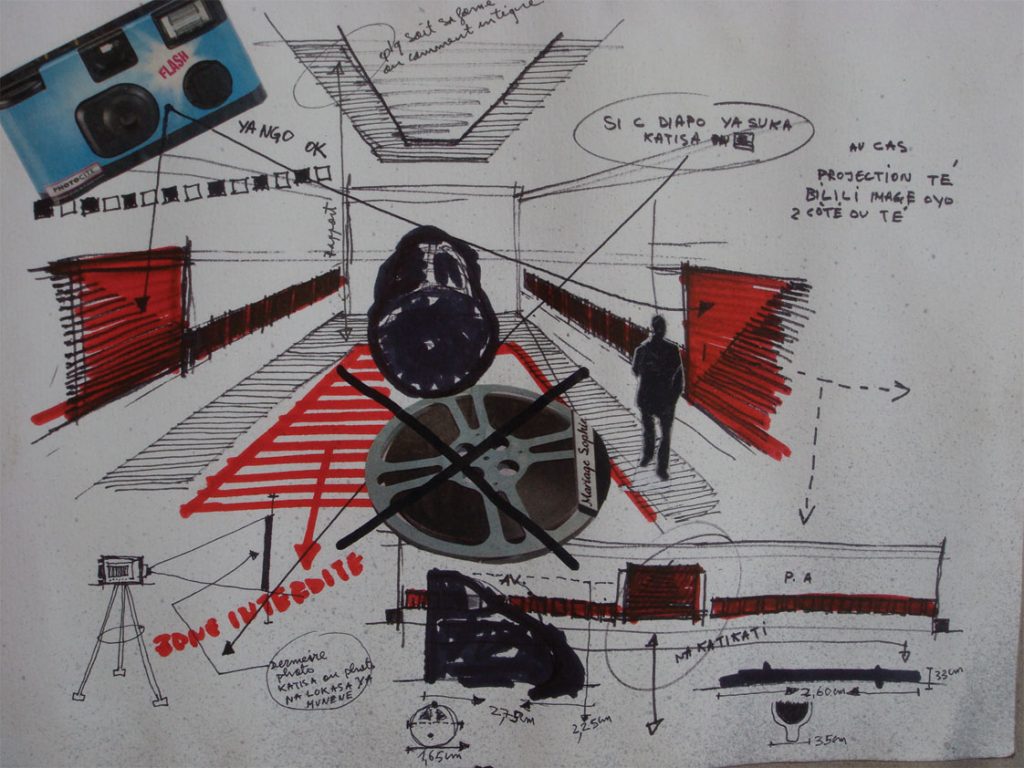

Such collapses, though in a different guise, mark Mingiedi’s work. Drawn or painted and at times rendered as full-scale models, they take the form of hybrid vehicles born of peculiar couplings: a dugout canoe and the nose cone of a 747 (Figs. 7A and 7B); a TGV bullet train filled with French politicians and a Kinshasa combi (a collective taxi/minivan, typically outfitted with wood benches and hugely overcrowded), positioned side by side or smashed into one another, products of an unlikely rear-end collision (Figs. 8A and 8B).37 In these implausible contraptions, once again linearity exits the picture: there is no way to tell in which direction the wheels are likely to turn. A bizarre wheelbarrow-cum-caterpillar earthmover designed by the artist in 2008 to transport artworks imported by a Parisian museum for an exhibit at the Beaux Arts academy in Kin looks just as likely to slide laterally (or up) as it is to proceed left or right on a horizontal plane (Fig. 9). Thoroughfares traversing his maps similarly run/morph into one another, forming maze-like intertwinings alternately reminiscent of lassos, fun house loop-d-loops and the circuitry of high-tech motherboards writ large, all of it leading everywhere and nowhere at once (Figs. 10A and 10B).


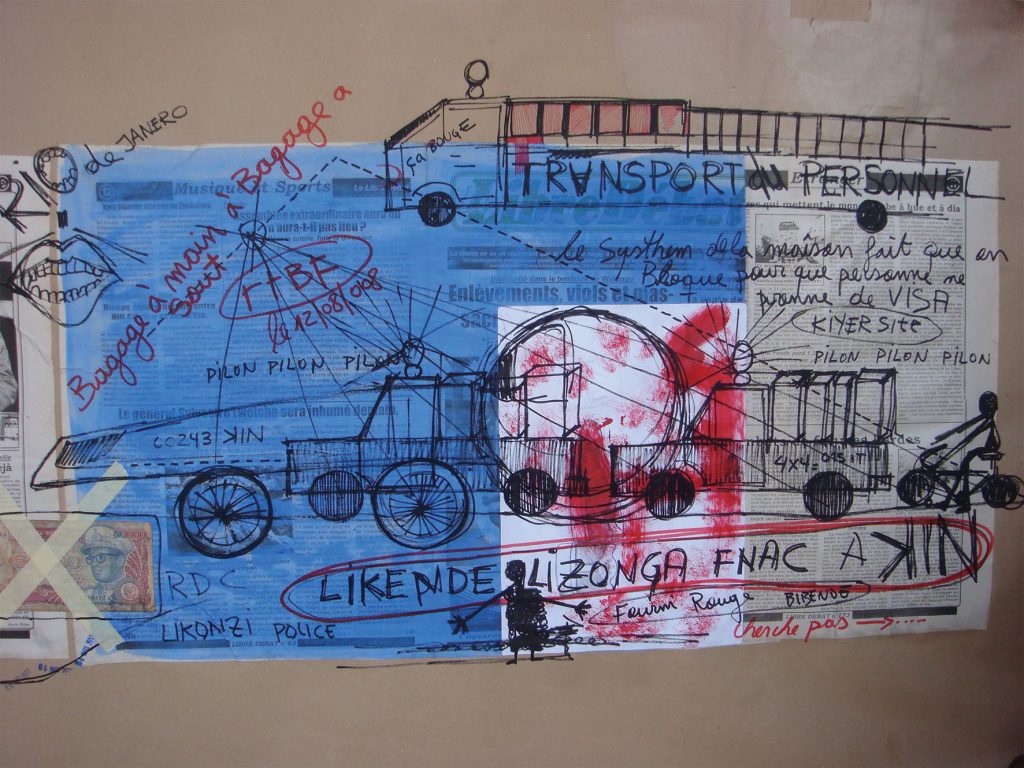


None of this, it should be noted, is happenstance. Mingiedi has not stumbled, à la art brut, on approaches to mapping that coincidentally echo those of such art world and theory luminaries as Teddy Cruz, Bernard Khoury or Eyal Weizman. Were he a European artist, this would scarcely need to be pointed out; in the realm of contemporary African(ist) art history, however, it must sadly be underscored, lest an artist who has dedicated significant time to formal study be categorised, like so many before him, as some manner of genius autodidact. While, to my knowledge, he has read neither Cruz nor Weizman and is not acquainted with Khoury, after years of formal training at the Beaux Arts Academy in Kinshasa, Mingiedi has spent a great deal of time, first as a student at Strasbourg’s Ecole Supérieure des Arts Décoratifs (ESAD), then as a collaborator on numerous design and installation projects across Africa and Europe, in the company of artists, scenographers and curators whom Cruz and co. and their forebears have mightily influenced.
The ESAD is home to a cadre of professor-practitioners who have long engaged in sophisticated mind-mapping experiments. Among these are several people with whom Mingiedi has worked closely, by whom he has been influenced and whose practice he has in turn impacted. Among them are Eléonore Hellio, whose art sans oeuvre weds inspiration from mind-mapping guru Tony Buzan,38 Dreamtime cartographies of the Noongar, Gagudju and related peoples of Australia, double-bind theory in its relation to complex systems and cybernetics, and Palo Alto School research on systemic clusters;39 Pierre Mercier, whose work explores coercive systems (dispositifs) as articulated by Michel Foucault and, in his wake, Giorgio Agamben; Jean-Christophe Lanquetin and François Duconseille, whose engagement with urban space and performance brings into play the writings of Hannah Arendt, Michel de Certeau, Dipesh Chakrabarty, Paul Gilroy, Achille Mbembe, Jacques Rancière, Georges Perec, AbdouMaliq Simone and others, all of whom emphatically reject both singular perspectives and linear approaches to the production of knowledge.
Public Space is the Place
For this Strasbourg-based crew and its closest collaborators, notably Béninois designer Frank Houndégla and French theatre director Jean-Paul Delore, public space is the space of record: the single most important point of entry for reflection on and engagement with the city. The same is true of Mingiedi, for whom it has been a central concern since his earliest days as a creator, and it is the primary locus of interest for those with whom he works most intimately in Kinshasa. These include designers Cédric Nzolo and Iviart Izamba, with whom he has founded a collective, K50, whose focus is the art of shaping public space through processes of ephemeral remapping.40
This shared, cross-continental interest in public space has fed a synergy between ESAD and the Académie des Beaux Arts in Kinshasa: a seven-year partnership between the two schools, in the context of which several Kinois students – notably Mingiedi and Nzolo – came to study in Strasbourg, ESAD students took part in workshops, exhibits and performances hosted by ABA, and faculty traveled back and forth between the two schools. This in turn has spawned a number of projects, in a wide range of locations and media, centering on radical interventions on and into urban public space.
One such project, ‘Urban Scenographies’, initiated in the late 1990s by Lanquetin and Duconseille41 and active ever since in cities across Africa and, more recently, Europe, brought Mingiedi to Johannesburg for a month-long multiple artist/writer/critic residency at the Drill Hall in Doornfontein in April 2009.42 There, he developed his most sophisticated and challenging work to date – a remarkable exercise in three-dimensional urban cognitive cartography entitled ‘Lelo Awa’ (‘Here Today’).
The brief for creators involved in the ‘Urban Scenographies’ residency was to develop projects inspired by and meant to reshape – for a minute, an hour, a day – public space in a five-block radius extending from the Drill Hall.43 All participants lived within this radius for a month – Mingiedi in the Hall itself – and, at month’s end, deployed their takes on space in a public three-day happening/festival/multipolar event. The World Cup was looming on the horizon and there was much talk in Doornfontein during this period about the impact that the new inner-city tram line being planned at the time would have on the taxi business – this an issue of some grievance given the presence, across from the Hall, of the infamous Noord Street taxi rank.
Given this general state of affairs and his long-standing fascination with urban routes and mobility, Mingiedi had much to think about. Add to this an interest on his part in football as a political phenomenon (this too a product of growing up in the shadow of Mobutu, who used the national football team, named in honour of his reign as self-proclaimed Leopard King, to highly effective political ends) and within hours of his arrival in Johannesburg Mingiedi was bursting with ideas. Shortly, he set about devising a moving installation that involved rolling a gigantic ball through the crowded streets of Doornfontein. The neighbourhood, home and transit point for thousands of car-less folk mired every day in endless traffic jams – people whose origins and economic condition, it was clear by this point, would not make them particularly welcome at the Rainbow Nation’s World Cup celebrations – was about to be steamrolled by a Kin-and-fut-inspired, space-invading take on the violence of movement and access curtailed (Fig. 11).

There were, however, two problems, which quickly became key concerns for the artist. First was the difficulty, given limited means, to produce a mega-ball large enough to satisfy the project’s intentions (the diameter was to be no less than 2.5 metres), yet robust enough to withstand the less-than-smooth pavement of central Jozi. The second was the neighbourhood itself. Although certain participants in the residency were fascinated by the veritable Babel of languages, practices, ways of thinking and doing of Doornfontein’s multi-national environment, Mingiedi was mostly appalled. The miserable living conditions, fear of deportation and police violence, gang activity and broken dreams he encountered among so many ‘local’ foreign Africans with whom he crossed paths on his forays through the area left him despondent. In the eyes of some, this might have been an exotic laboratory for sociological observation. For Mingiedi, it was just more of what he had seen elsewhere – in the hell that Kin had become by the late 1990s, following the state’s collapse and the attendant trail of destitute men, women and children streaming from everywhere into a city that wanted nothing to do with them; and in the ugly world of constant ID checks, holding cells and baton-wielding military police that greets African immigrants in many a European city. Most depressing, for him, were the homeless Zimbabweans adrift in Doornfontein and nearby Hillbrow. This was emphatically not what he had had in mind when he stepped off the plane at OR Tambo International Airport.
Mulling all of this over, Mingiedi took to his room. When he emerged a few days later, he had a plan: he would not leave his room at all. If public space in Doornfontein had become for so many a space of broken private lives, then he would contrive to explode private space, turning it into a radical reincarnation of public interaction. The project was properly bizarre and simply brilliant. First, he put a multilingual sign up on his door identifying the room’s occupant – in Lingala, French and assorted broken versions of South Africa’s eleven official tongues – as a Zimbabwean in Johannesburg (Fig. 12). The white on black design of the sign looked more like a wanted poster than anything else and, that, of course, was the goal. Then he got to work, inviting those who cared to do so to come in and see what he was up to.
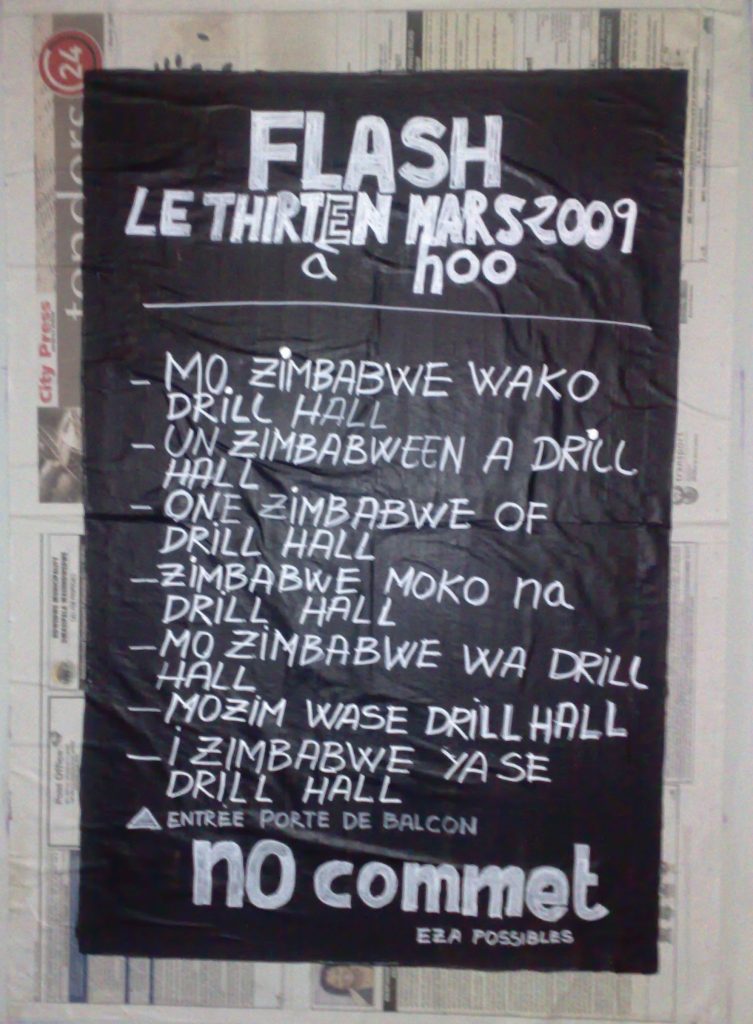
Shortly, however, getting in got complicated. Mingiedi, it turned out, was building that massive ball inside the room and the object was no small contraption. It reached from floor to ceiling and left little space along the sides – just enough (a kind of narrow viewing gallery) to see a mural extending over the four walls: a drawn, painted and collaged cartography radically collapsing Joburg into Kinshasa, so that there was absolutely no way to tell where one city began and the other ended. In the first days (or, rather, nights – the wee hours being the best to encounter Mingiedi at his most inspired), it was easy enough to enter the space, as he was in the process of constructing the ball’s armature, this out of plastic tubing used to house electric cables. If need be, to get from one spot along the mural to another, you could step gingerly through the coils of tubing. When the whole armature was up, however, this was no longer an option (Fig. 13A and Fig. 13B).


Then movement in and out became even more complicated, as the artist embarked on creating a cardboard shell for the ball (Fig. 14). If you were thin enough to squeeze by, you inevitably found that the mural had changed since the last time you’d come through, growing to incorporate an increasing number of references to the work being done by other members of the residency. Mingiedi might not have been leaving his room other than for an occasional walk down the hall to shower or relieve himself (he had devised a sleeping-cum-food-bag arrangement that hung in a coil from the ceiling and was rolled out in one of the viewing aisles when sleep or sustenance was required)44, but he kept very much abreast of activities in and around the Drill Hall and, as headlines cribbed from daily newspapers and incorporated into the mural showed, he was making sure to stay on top of goings-on in Johannesburg and the world more generally. This latter process got even more interesting when headlines, entire articles and grainy color photographs began appearing on the ball itself.
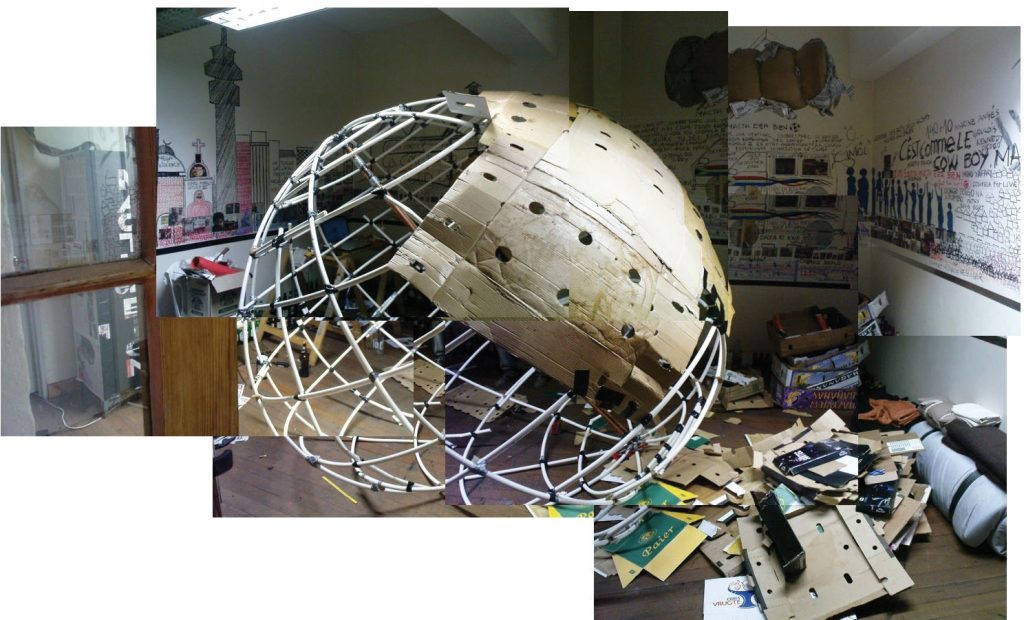
Mingiedi, it turned out, had undertaken to cover the entire sphere in newsprint. Most regular onlookers had expected this process to take at least several days and were looking forward to reading the world, as it were, for by this point the ball at the centre of the increasingly complicated cityscape inscribed on the walls had started to look like a planet rotating at the core of an urban implosion. But no: in a single, frenzied night, Mingiedi managed to coat every inch of the ball, resulting in a sight so peculiar it looked properly psychedelic (Fig. 15A and Fig. 15B). A row of empty beer and cheap whiskey bottles running the entire length of the floorboards, evidence of a per diem liquidly spent, glimmering in light streaming in through the room’s one window, served to anchor the eye, offering a form of scansion for gazes that could scarcely find a point on which to settle in the buzz of implied movement filling every inch of the space.
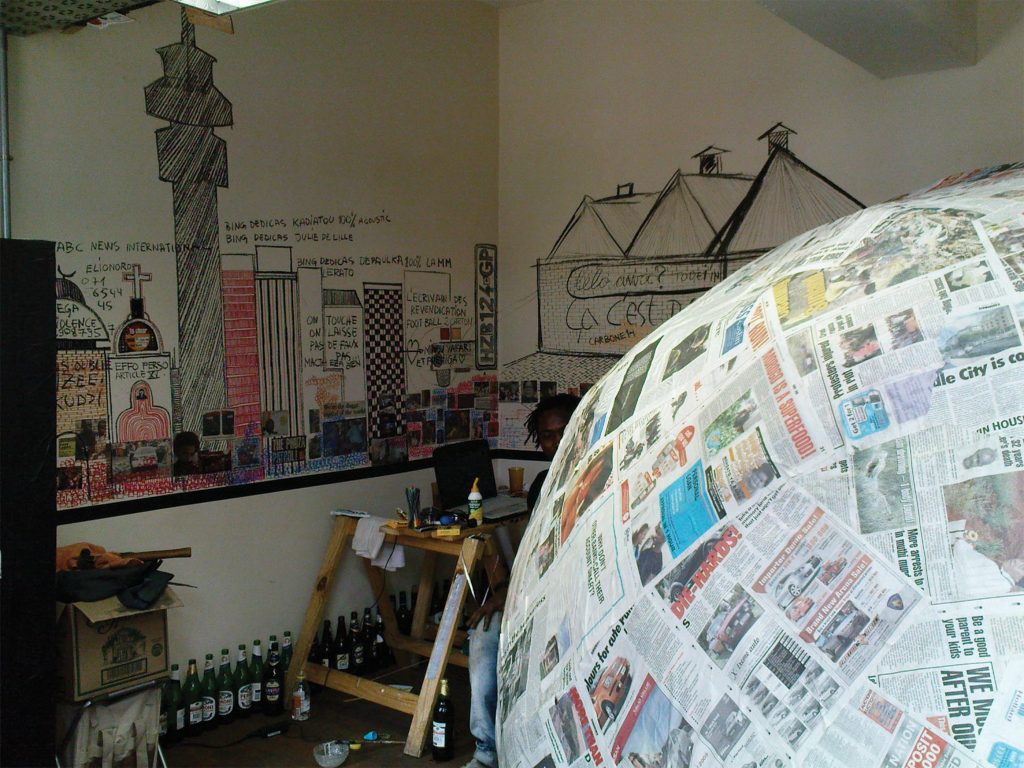
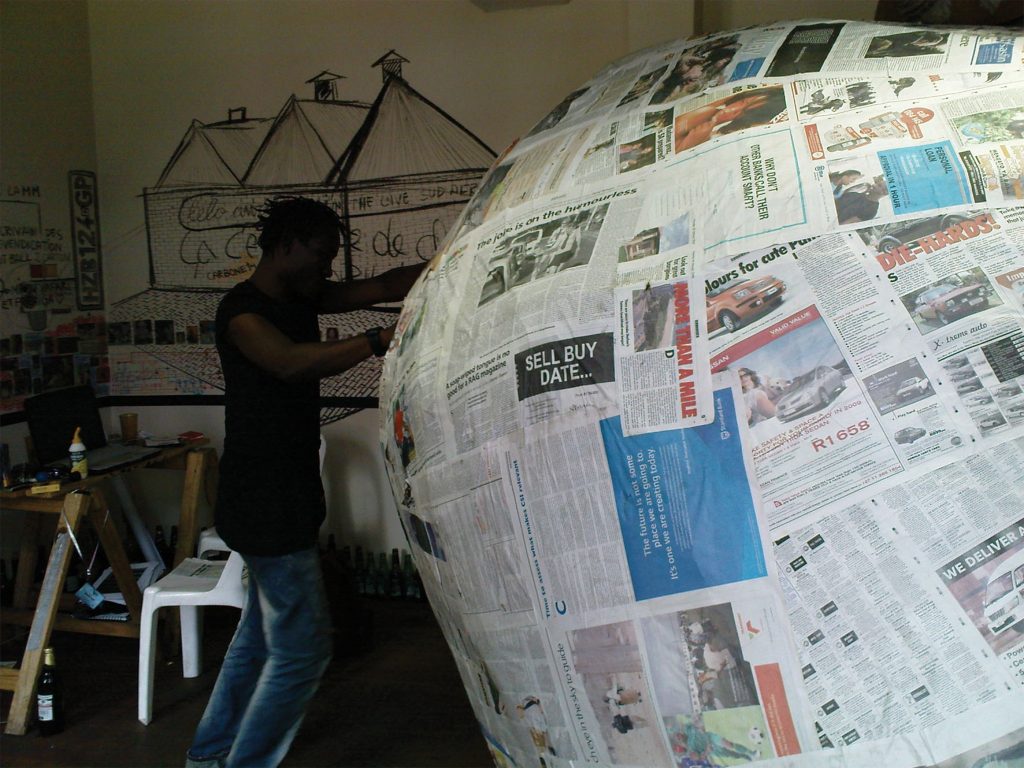
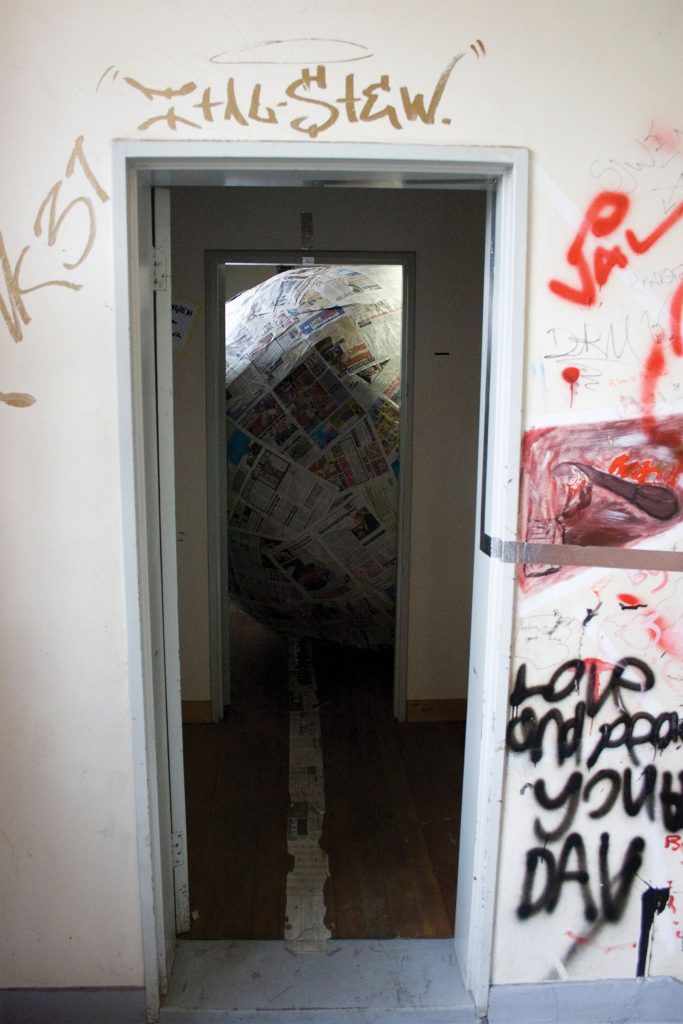
By the time the news-covered ball was finished, the only way in and out of the space was through the window. This might have discouraged many – walking by the door to Mingiedi’s room, you could see that no access was possible (Fig. 16) – but at this point the ball-room had become such a source of curiosity that people were lining up on the fire escape for a look and possible visit. Private space had quite literally become public, in a haunting echo of the Gaza bed- and living-rooms described by Weizman: personal, indoor spaces transformed into public thoroughfares by the wrecking ball panopticon-on-the-move of the Israeli war machine.45 Here, however, a reversal had been operated. The ball was on the inside, claimed as his very own panopticon by the Congo-Zimbabwean at the heart of it all, along with not one but two cities (Joburg and Kin melting into one another) and a host of others adding guest appearances to the mix (a building plucked from the Manhattan skyline, an odd, pickle-shaped structure straight out of Dubai). The ball had no intention of wrecking anything, but it did make a dead-serious point: in a late capitalist public sphere that, on grounds of origins, complexion, accent or absence of means, denies many the right to decent private space (or, indeed, to any private space at all), there are the means – anger, imagination, sheer determination – to create bedlam from the inside out. What had begun as a wholly speculative experiment46 had turned into a full-fledged model for radically rethinking the urban borderlines between public and private space. Gaza, referenced also in the mural by way of comparisons with the ultra-violent ‘Red Ant’ evictions taking place throughout Doornfontein at the time,47 was present in the heart of inner-city Johannesburg and, at Mingiedi’s hands, most definitely intent on talking – and taking – back.
A constant question from onlookers, first among them those who thought the whole thing should be somehow preserved and collected – ‘how are you going to get the ball out of there?’ – unwittingly added to the message inherent in the installation. In one of the most implausible and, uncannily, one of the most logical mixes one could imagine, the spirits of French playwright Eugene Ionesco and Cameroonian filmmaker Jean-Pierre Bekolo had managed to meet up at the Drill Hall – the former by way of his play Amédée ou comment s’en débarrasser (1954) and the latter via his film Les saignantes, two Ubuesque tales in which efforts to get rid of an unwieldy object make the lives of assorted city dwellers increasingly complicated and absurd. In both cases, the object is a corpse. In Ionesco’s play it is a body that will not stop swelling, taking up more and more space, and in Bekolo’s film it is a deceased john who, despite attempts to cut his remains into disposable pieces by the prostitutes on whose watch he has died, keeps on reappearing in the most inappropriate public places.48 In both instances, the increasingly present corpse is the proverbial pink elephant: the THING taking over, whose presence no one will fully acknowledge. In the confines of Mingiedi’s room turned public viewing chamber, the THING was not literally (or even symbolically) a corpse, but it did lend itself to a reading as a deceased entity: the Modernist city. In the urban heart of a neighbourhood that had once been Apartheid South Africa’s proudest claim to Modernist identity – so much so that it billed itself as ‘Little Manhattan’49 – the artist had created the ultimate rebuke to Modernist teleologies of unilinear, forward movement: a moving object that staunchly refused to move, inside a space that just as staunchly refused to be what its architecture dictated that it be, a closed and private space. It chose instead to become a public arena in which visitors were confronted not with one city, or even two, but with an Afrofuturist layering of urban cartographies in which all cities were suddenly one and one city was all others.
This piece features in African Cities Reader 2: Mobilities & Fixtures (May 2011). To purchase in print head to our online shop.
1. For their generosity in sharing ideas and images as I was writing these pages, I wish to thank several people: the artist Méga Mingiedi, whose work is at the core of this essay and with whom I have had the pleasure of many long conversations in DRC, South Africa and France over the past year and a half; François Duconseille and Jean-Christophe Lanquetin, who first introduced me to Mingiedi, invited me to take part in a Johannesburg residency with him in 2009, and whose photography of the artist’s work during this residency appears herewith; Eléonore Hellio, whose analyses and reading suggestions have proven a key source of inspiration; Dicoco Boketshu Bokungu, to whom I am most grateful for his guidance as I seek to navigate the complexities of Kinois social and political space; Christian Hanussek, who first encouraged me to write about one of the works by Mingiedi discussed in this essay, ‘Kin Délestage’ (Fig. 1).
2. Edgar Pieterse, AbdouMaliq Simone et al, http://africancentreforcities.net/programmes/academic-research
3. Mumford (1895-1990) was indubitably a remarkable writer, and an encyclopedic one as well. His most famous book, The Culture of Cities (1938) is an essential text that shaped (and continues to shape) generations of urban historians. At its core, however, is a fundamental lacuna: its failure to engage in any meaningful way with non-European urban cultures – with the predictable exceptions of Ancient Egypt and Mesopotamia. This tends to be blamed on ‘an absence of sources due to the epoch in which he was writing’ (see, notably, Corinne Beutler’s review of Mumford’s opus in Annales: économies, sociétés, civilisations (1996) Vol 21, No. 4, p. 919). This is a dubious argument, given the ample coeval data on China, India and – yes – Africa, and it is of little comfort today, as many writers persist in this failure to engage with what they take to be the urban ‘Other’ and, in tandem, re-assert the kinds of centre-periphery divides that structure most of Mumford’s otherwise fascinating analyses.
4. Dominique Malaquais (2006) ‘Douala/Johannesburg/New York: Cityscapes, Imagined’, in Garth Myers and Martin Murray (eds) Cities in Contemporary Africa, New York, Palgrave Macmillan; Edgar Pieterse (2008) City Futures: Confronting the Crisis of Urban Development, London, Zed Books; AbdouMaliq Simone (2004), For the City Yet to Come: Changing African Life in Four Cities, Durham, Duke University Press.
5. For a fine – and a prescient – analysis of the extraordinary failure of the imagination that shaped the lead-up to and the execution of the 2010 World Cup, see Achille Mbembe’s (2006) well-known text on the subject, ‘2010 World Cup: Where is the moral argument?’,
http://webcache.googleusercontent.com/search?q=cache:mhnHYiIXXM8J:www.africultures.com/index.asp%3Fmenu%3Drevue_affiche_article%26no%3D5757%26lang%3D_en+achille+mbembe+world+cup&cd=2&hl=fr&ct=clnk&gl=fr
6. For discussions of these and related issues as concerns Cairo and Nairobi, two recent publications offer a useful introduction: Diane Singerman and Paul Amar (eds) (2006) Cairo Cosmopolitan: Politics, Culture and Urban Space in the New Globalized Middle East, Cairo and New York, The American University in Cairo Press; Hélène Chartron-Bigot and Deyssi Rodriguez-Torres (2006) Nairobi contemporain, les paradoxes d’une ville fragmentée, Paris and Nairobi, Karthala and IFRA. For those who hoped that things might change in Cairo following the wave of protests that toppled Hosni Mubarak, recent crackdowns by the army in what had become the very symbol of urban uprising in the face of status quo rule – Tahrir Square –are reminders that the violence of capitalism and its disastrous impact on cities brook little contradiction.
7. Lagos Wide and Close: An Interactive Journey into an Exploding City, documentary film, directed by Rem Koolhaas with Bregtje van der Haak [DVD]. See also,
http://www.oma.eu/index.php?searchword=lagos&option=com_search&Itemid=19
8. See note 3.
9. Dominique Malaquais (2004) ‘Sexing Africa, Again: Watch it Tonight on HBO’. Chimurenga Vol. 5.
10. The intimate ties that the New York Prada store is meant to entertain with Lagos – the point being one less of formal influence than of mood, ethos, approaches to movement, mutability, multisensorial effects, experimentation and so on – are articulated, in various forms (text, image, transcriptions of [possible] conversations) in AMOMA / Rem Koolhaas / Simon Brown and Jon Link (2004), Content (Perverted Architecture), Cologne, Taschen, pp. 290 291, 324 325, 326 331.
11. See http://www.oma.eu/index.php?option=com_projects&view=portal&id=1191&Itemid=10
12. Koolhaas’ legendary irreverence and fascinating takes on shopping notwithstanding (or arguably because of these), it is worth noting that, in presentations of its plans for Lagos, OMA includes images of a Prada store on the lower deck of the Fourth Mainland Bridge. (There is talk also of Koolhaas designing a Guggenheim franchise for Lagos (Content, pp. 290-291), possibly to replace the Guggenheim Soho, in whose place the OMA Prada New York now stands). In OMA’s design, the Prada store in Lagos appears alongside roadside food-vendors’ stalls (http://africapractice.blogspot.com/2010/06/lagos-megacity-or-crisis-city.html) – an unlikely combination given the Lagos State governor’s stand on ‘informal’ commerce, as demonstrated by the complete raising in January 2009 of Oshodi Market, one the city’s most important sites for unregulated trade, which Koolhaas himself had earlier identified as a locus of particular interest for his analysis of Lagos. See http://www.oma.eu/index.php?option=com_content&task=view&id=166&Itemid=25
13. See http://www.lacitedufleuve.com and
http://lepotentiel.com//afficher_article_archive.php?id_article=83508&id_edition=4729&yearID=2009&monthID=07&dayID=13
14. See note 11 and http://www.skyscrapercity.com/showthread.php?p=50815969
15. Katanga Business (2009), Film, directed by Thierry Michel, http://www.katanga-lefilm.com
16. See http://www.luanocity.com
17 ‘Afropolis: City, Media, Art’, curated by Larissa Förster, Christian Hanussek and Kerstin Pinther, is a multimedia exhibition that focuses on five cities in Africa: Cairo, Johannesburg, Kinshasa, Lagos and Nairobi. It opened at the Rautenstrauch-Joest Museum in Cologne on 5 November 2010. The curators articulate the show’s goal and structure as follows: ‘The curatorial approach highlights the interconnectedness of scientific and artistic concepts, not only exploring urban histories and recent developments, but also presenting 30 artistic viewpoints on issues of urbanity about and from these five cities. The result is a remarkable synergy of scientific and artistic research, documentary material and artistic reflection. The works shown in Afropolis include graphic arts, painting, photography, sculpture, installation, film and video art, as well as design, comics and weblogs.’ See http://www.afropolis.net and http://museenkoeln.de/rjm. An extensively illustrated, German/English catalogue accompanies the exhibition,
http://www.buchhandlung-walther-koenig.de/verlag/empfehlungen/aesthetische_theorie/isbn_3865608981.aspx
18. As the foregoing suggests, I find notions of ‘formality’ and ‘informality’ to be of little use in thinking about spaces and economies, urban and otherwise. Readers familiar with the SPARCK project (Space for Pan-African Research, Creation and Knowledge/The Africa Centre), which I co-direct with my friend and colleague Kadiatou Diallo, will recognise this take, which underlies all of the projects supported by SPARCK. See http://www.sparck.org
19. ‘Kin Délestage’ is exhibited in ‘Afropolis: City, Media, Art (see Note 17) and appears in the show’s catalogue (text by Dominique Malaquais). I am grateful to Christian Hanussek for providing me with the high-resolution photograph of the piece that appears here.
20. Méga Mingiedi (2010) personal communication, April.
21. The edifice is the work of French architect Olivier-Clément Cacoub (1920-2008), builder of choice for many an African dictator. It was erected under Mobutu, but not quite completed. The finishing touches were added, with great fanfare, by Joseph Kabila.
22. See also a football stadium, framed in an oval of purple viewing stands, at bottom left.
23. Richard Russo (2009) That Old Cape Magic, New York, Random House.
24. It goes without saying that other parts of the city, with a few notable exceptions, underwent no such transformations. La modernité was for the rich and, most importantly, for a politically and economically motivated show. See Dominique Malaquais (2009) ‘Rumblin’, Chimurenga Vol. 11.
25. This list of sites referenced in Mingiedi’s work stems from a discussion with the artist in October 2009. While the reactor was not built by Mobutu (it was the brainchild of a peculiarly nuclear-obsessed Belgian cleric, one Monsignor Luc Gillon, who set it up on the campus of the University of Kinshasa in 1959), it was a source of great pride for the dictator and, in 1970, was upgraded by Gillon at Mobutu’s behest. It has remained active since then, if in a disastrous state of decay (Michaela Wrong (2000) In the Footsteps of Mr. Kurz: Living on the Brink of Disaster in Congo, London, Harper Collins.
26. Michaela Wrong (2000) In the Footsteps of Mr. Kurz: Living on the Brink of Disaster in Congo, London, Harper Collins.
27. See http://www.conservapedia.com/Joseph_Mobutu
28. Footage of an inconclusive rocket launch can be seen in the first film in Thierry Michel’s trilogy (referenced above), Mobutu Roi du Zaïre (1999). The same footage appears in low resolution on YouTube:
http://www.casttv.com/video/haddp71/le-programme-spatial-de-mobutu-une-vido-de-nzwamba-fuse-mobutu-zare-rdc-espace2-video
29. As previously stated (Note 21), the massive tower (150 metres) was almost, but not entirely, completed by Mobutu. The finishing touch was brought by Joseph Kabila. It is a statue of Patrice Lumumba, initially planned for but ultimately set aside by Mobutu, and which (much to the chagrin of Lumumba’s widow Pauline) now stands in front of the tower. In a brilliantly cynical move, Mobutu raised Lumumba, whose demise he had actively aided and abetted, to the status of national hero/martyr and built the tower in question in his honour; but he decided against topping or flanking it with an effigy of the man. In an equally cynical and politically astute move, Kabila Jr. took over where Mobutu had left off, appropriating the memory of Lumumba, much as his father had before him, to add weight to his much-questioned legitimacy as ruler of present-day Congo.
30. I am grateful for this insight to Cédric Vincent, with whom I have had numerous exchanges on the nature of Africa-based Afrofuturist production in literature, the arts and architecture.
31. Such influence stems in part from the fact that, unlike many postcolonial leaders, Mobutu actively supported the arts. Granted, his support went to those, specifically, who served his reign. Still, modeling himself on the continent’s few other exceptions in this vein (Guinea’s Sékou Touré, Senegal’s Senghor), he created an academy of fine arts that continues to attract many students today, Mingiedi included, who attended Kin’s Académie des Beaux Arts for several years.
As noted, other influences can be adduced, alongside Mobutu’s sci-fi bent, for the interest in things futuristic encountered among Kinois artists. Among these, one might mention the violence of a colonial and a postcolonial system so sadistic that imaginaries of a far-off future have proven for many an only and last redoubt, as well as wave after wave of religious and millennial prophetism, which have washed over the country since its earliest encounters with Europe. The latter, in a striking mix of genuine spiritual sensibility and biting irony, is reflected in numerous Mingiedi works.
32. See André Magnin et al (2001) ‘Bodys Isek Kingelez’, Hamburg and Ostfildern-Ruit, Kunstverein im Hamburg/Hatje Cantz Verlag.
33. See Filip de Boeck and Koen van Synghel (eds) (2008) The World According to Bylex, Brussels, KVS and Africalia. The book (an exhibition catalogue) is accompanied by a 69-minute video documenting the artist’s practice, entitled Percer les mystères de l’invisible (Piercing the Mysteries of the Invisible).
34. See Le palais d’artiste de Bienvenu Nanga – Ingrédients et mode d’emploi (2007), documentary film, directed by Edwina Hoël, ASP Production / Centre Culturel Français de Kinshasa.
35. I mean by this an engagement premised less on form (interest in a futurist ‘look’ that has become something of a fashion in Kin’s world of art for sale to European collectors of Afro-kitsch and -cool) than on a poetic and politically charged interest in the tactical possibilities of alternative realities and time-space continuums.
36. See http://sparck.org/about-mowoso; http://sparck.org/about-gou; http://sparck.org/work-in-progress. See also Dominique Malaquais (2011) ‘(De) Facing Rage’, in V. Smith, S. Stemmler and C. Hamschmidt, (eds) RAGE, Berlin, Revolver Publishing.
37. For photography of a stunning mural of precisely such a collision, created by Mingiedi on the façade of his house in Kinshasa, see the edition of the French contemporary arts journal Livraison (2011) No. 14, edited by François Duconseille, Frank Houndégla, Jean-Christophe Lanquetin and Dominique Malaquais.
38. Tony Buzan (1996), The Mind Map Book, London and New York, Penguin Books.
39. John Weakland and Paul Watzlawick (eds) (1981) Sur l’interaction, Palo Alto 1965-1974, une nouvelle approche thérapeutique, Paris, Seuil .
40. For an introduction to Nzolo’s work on public space, see ‘Let There Be Light’ (2010), an intervention co-curated by Dominique Malaquais and Cédrick Nzolo, in Transition 103.
41. See http://www.eternalnetwork.org/scenographiesurbaines/index.php. See also Dominique Malaquais (2008), ‘Douala en habit de festival’ Africultures 73.
42. See http://www.eternalnetwork.org/scenographiesurbaines/index.php?cat=joburgresidency
43. In no instance was such reshaping to leave a permanent mark. Indeed, one of the most interesting – and refreshing – aspects of the ‘Urban Scenographies’ project as a whole, in all of the cities where it comes into play, is its active refusal to ‘fix’ the urban environment. In some rare cases, it should however be noted, interventions do end up having a longer-lasting impact, a case in point being a bridge that Mingiedi created using a discarded 18-wheeler truck axel on the occasion of ‘Urban Scenographies Kinshasa’, which took place in 2007. The bridge changed the lives of hundreds of inhabitants in a neighborhood bisected by an until-then impassable river-turned-sewer, and is still in use today.
44. See Fig. 13A and Fig. 14.
45. Eyal Weizman (2007) Hollow Land: Israel’s Architecture of Occupation, London and New York, Verso.
46. Mingiedi did not know if any of this would work and at first expressed repeated concern about it.
47. In advance of the 2010 World Cup, the government embarked on a ‘beautification campaign’ meant to make South African cities more attractive to foreign visitors. In Johannesburg, the campaign proved particularly ruthless. It was accompanied by a wave of violent evictions in which poor immigrant families were beaten and ousted from whatever homes they had managed to make for themselves, their meager furnishings trampled and burned by gangs of rent-a-thugs known as ‘Red Ants’ for their fire-engine red overalls and helmets. The Ants’ employers were the provincial department of public transport and related state outfits. Braam Hanekom, the chairman of Passop, a refugee rights organisation, offers a pithy definition of their job: ‘They are essentially a militia that ruthlessly and forcefully displaces people from their shelters under government instructions. They are notorious for their brutal and violent approach towards the poor’ (Dan McDougall (2010) ‘Red Ants Clear Slums South Africa-Style’, The Sunday Times (UK), 10 April.)
During their stay in Doornfontein, the ‘Urban Scenographies’ participants witnessed several Red Ant evictions, the area immediately surrounding the Drill Hall being high on the ‘clean-up’ list of the local authorities. The majority of those who lost their homes were Zimbabweans living in abandoned buildings of the inner city. Descriptions of the early-morning rousts by the riot-gear-equipped Ants, complete with accounts and photographs of bleary-eyed and often bloody evictees staring at defenestrated mattresses, pots, pans and children’s toys, were chilling. A sense of helpless horror pervaded the Hall.
For a sense of what the inner-city Joburg Red Ant evictions entailed physically, see:
http://www.mediaupdate.co.za/default.aspx?IDStory=25297, http://1.bp.blogspot.com/_A6KsRAiehsM/StXujQrUi3I/AAAAAAAAA50/GeGwBiEt4Ek/s400/web07.jpg,
http://media.photobucket.com/image /red%20ants%20evictions%20johannesburg/drevil5000/STclean746.jpg,
http://media.photobucket.com/image/red%20ants%20evictions%20johannesburg/drevil5000/STclean746.jpg
48. I am grateful to Elisabeth Malaquais for her suggestion that I consider Mingiedi’s installation in relation to Ionesco’s Amédée.
49. On Apartheid Johannesburg’s (and more broadly urban Apartheid South Africa’s) quest to become ‘Modern(ist)’, see among others: Clive Chipkin (1993) Johannesburg Style: Architecture and Society 1880s-1960s, Cape Town, David Philip; Gilbert Herbert (1975), Martienssen and the International Style: The Modern Movement in South African Architecture, Cape Town and Rotterdam, A.A. Balkema; Jonathan Hyslop (2008) ‘Ghandi, Mandela, and the African Modern’, in Sarah Nuttall and Achille Mbembe (eds) Johannesburg: The Elusive Metropolis, Durham and London, Duke University Press, pp. 119 136; several essays in Hilton Judin and Ivan Vladislavic (eds) (1998) Blank _ Architecture, Apartheid and After, Rotterdam and Cape Town, NAi Publishers and David Philip: Clive Chipkin, The Great Apartheid Building Boom: The Transformation of Johannesburg in the 1960s; Derek Japha, The Social Programme of the South African Modern Movement; Tony Morphet, Personal Traits: The Work of Eaton and Biermann in Durban; Melinda Silverman, Ons Bou Vir die Bank: Nationalism, Architecture and Volkskas Bank.
